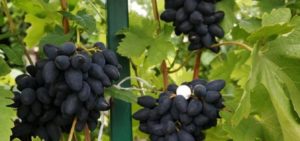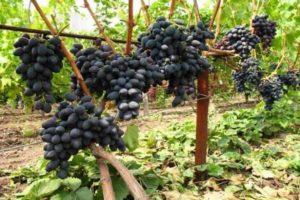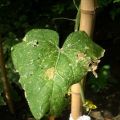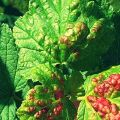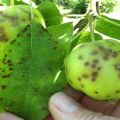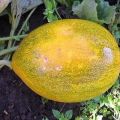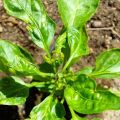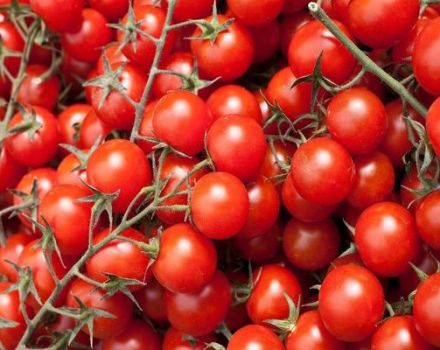How to process grapes from anthracnose, treatment and control measures with folk and chemical means
In a short time, an entire vineyard can die from anthracnose on grapes. Previously, winegrowers of the southern regions, where the climate is humid and warm, had to fight this scourge. Now the problem is increasingly faced in regions with a temperate climate. Hybrids (varieties) with high resistance to powdery mildew are prone to the disease.
Signs of anthracnose
In its advanced form, anthracnose grape disease affects the entire plant. Constant monitoring is required to avoid crop loss. Young leaves are the first to suffer. Small dark spots form on their surface. They increase in size in a short time, turning into spots.
The color of the neoplasms on the leaves is brown, the edges are darker. Because of these spots, the disease is popularly called spotted anthracnose. The affected surface can cover the entire area of the leaf plate, its color becomes dirty pink over time.
The diseased leaves eventually dry out and fall off, the infection spreads further, passes to the shoots. Brown spots appear on them, which grow in breadth and in depth, becoming dark brown. Cracks appear in the affected areas. If the days are dry and hot, diseased shoots dry out and break. They start to rot in rainy weather.
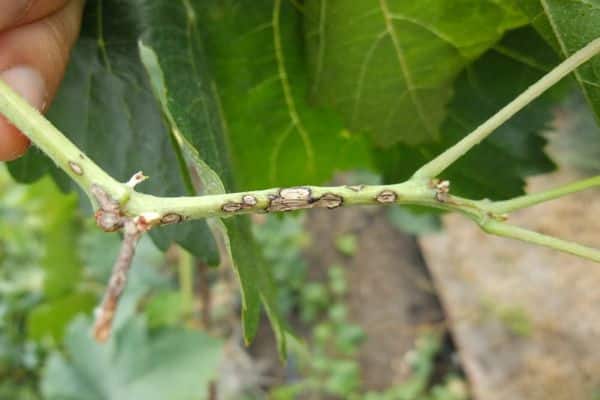
On berries, the infection manifests itself in round, concave spots inward. Their main color is brown, only the central part is purple. Sick berries dry up, crumble. Anthracnose on the brushes can be seen before the flowers bloom. The spots appear on them the same as on the shoots. The part of the brush located below the spot dies. The one that is higher continues to develop, but does not yield a harvest, since the ovary falls off over time.
Causes of the disease
The causative agent of anthracnose is a fungus of several types: Kabatiella, Gloeoporium, Colletotrichum. All its varieties are very tenacious, they are not afraid of cold snaps, spores winter on plant debris and on diseased vines.
A fungal infection may not manifest itself for years, and its onset can be triggered by:
- incorrect trimming;
- mechanical injury to shoots;
- bad weather (rain, hail);
- the soil is acidic, saline;
- lack of phosphorus, potassium in the soil.

Favorable environment for active reproduction of the fungus - high humidity of air, soil and temperature regime from 23 to 35 °C.
How to fight and how to treat
Only a systemic fight against infection guarantees the salvation of the vineyard from anthracnose. You should not give up when symptoms of the disease appear. You can cope with the fungus.You just need to know how to handle a diseased vine. Symptoms of anthracnose appear in the spring, they need to be treated immediately, all activities must be carried out before mid-summer.
Agrotechnical measures
Agrotechnical measures are the first method of treating anthracnose. It is especially effective if the vineyard area is small, you can process each vine:
- cut out diseased brushes;
- cut the leaves;
- cut off shoots with traces of the disease, grabbing up to 4 cm of a healthy area.
All scraps must be poured into a polyethylene bag; they cannot be thrown on the ground, this can lead to further spread of the fungus. After the completion of sanitary work, all plant waste must be burned.

To reduce the activity of the fungus, reduce watering. As a result, the topsoil (1 cm) becomes dry. Row spacings are cleared of weeds, this also reduces moisture in the root zone. The final stage is feeding. To increase immunity, phosphorus-potassium fertilizers are applied.
Drugs
Now there are no problems with the acquisition of effective drugs for the fungus. Winegrowers prefer biological products. They work well against fungus, do not harm the environment (insects, soil), and are safe for humans and pets.
Popular drugs against anthracnose:
- Plantriz;
- "Gaupsin";
- Mikosan.
The preparations from this list have been tested in practice by many winegrowers. No influence on the quality of the crop (taste, composition) was noticed. A positive effect on the formation and growth of shoots was noted. After treatment, the plants quickly restore the volume of green mass. Treatment with these drugs is carried out every 2 weeks.
Fungicides
With advanced forms of the disease, systemic fungicides from anthracnose are used. According to reviews, good results are achieved when using "Ridomil", "Fundazol", "Acrobat". Vineyards can be treated with other preparations:
- bordeaux mixture;
- "Fitosporin M";
- "Trichodermin";
- DNOC.
The vineyard is treated in the spring, when the shoots have just begun to grow and do not exceed 10 cm. Treatments with a fungicide solution are carried out only in the evening and morning. This avoids sunburn on the leaves.
Traditional methods
Any experienced winegrower will say that treatment with folk remedies will not give positive results if signs of anthracnose appear on the leaves and shoots, brushes. It is pointless to spray the bushes with soda, kefir, potassium permanganate and other similar means.

There is no need to be afraid of chemistry, only modern drugs will help to cope with a harmful fungus. Biologicals, systemic fungicides and agronomic measures are the only correct ways to combat anthracnose.
Prevention
A well-kept vineyard is less likely to suffer from anthracnose. The main preventive measures: timely and correctly carried out sanitary and formative pruning (spring, autumn), in summer - pinching. A neglected, thickened vine often suffers from fungus.
All work in the vineyard is carried out with a clean instrument treated in a solution of potassium permanganate. Leaves and shoots can also be sprayed with the same composition before processing. In the spring, prevention is carried out in several stages:
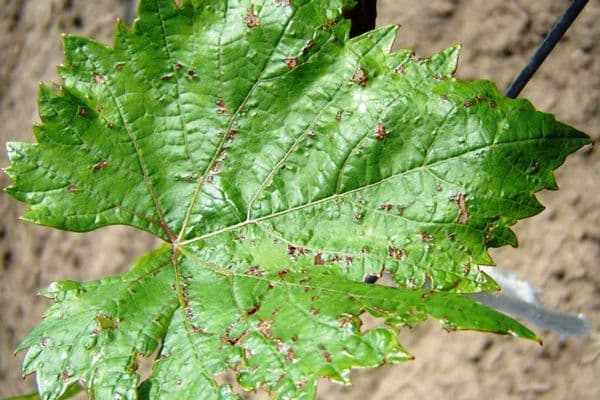
- the first stage before flowering is spraying with Bordeaux liquid (1%);
- second stage two weeks later with copper oxychloride solution.
Sulfur powder protects well against anthracnose. For prevention, they pollinate the vineyard in the spring. After summer thunderstorms, heavy rains, the bushes are sprayed with a fungicide or Bordeaux liquid.
Autumn preventive work:
- fertilization (potash, phosphorus);
- sanitary pruning of sick, damaged shoots, their destruction;
- raking and destroying all leaves;
- processing of row spacings (loosening);
- covering the soil with mulch.
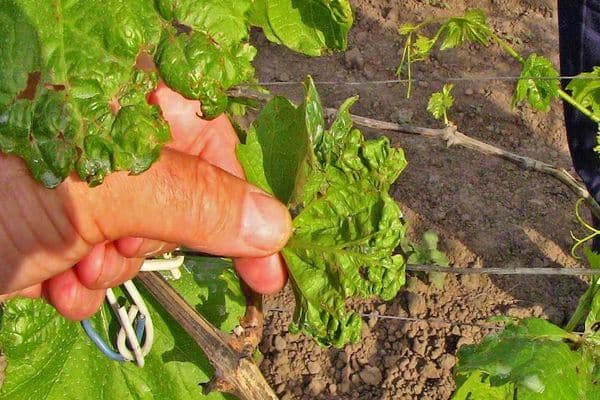
Most commonly affected varieties
Mildew resistant cultivars are likely to suffer from anthracnose. Experienced growers have found that varieties are most susceptible to disease:
- Husayne;
- Isabel;
- Karaburnu;
- Lydia.
Of the varieties of the old selection, they are relatively resistant: Riesling, Chasla Belaya, Saperavi, Cabernet-Sauvignon, Nimrang, a hybrid form of Viorica. Modern selection does not stand still. New varieties and hybrid forms of grapes appear, the resistance of which to anthracnose is not yet available in the scientific literature.
The choice of grape variety (hybrid) affects the health of the vineyard, but in practice the resistance to fungus does not always correspond to the one declared by the breeders. Only basic knowledge of vine care and preventive measures will help preserve the harvest.
